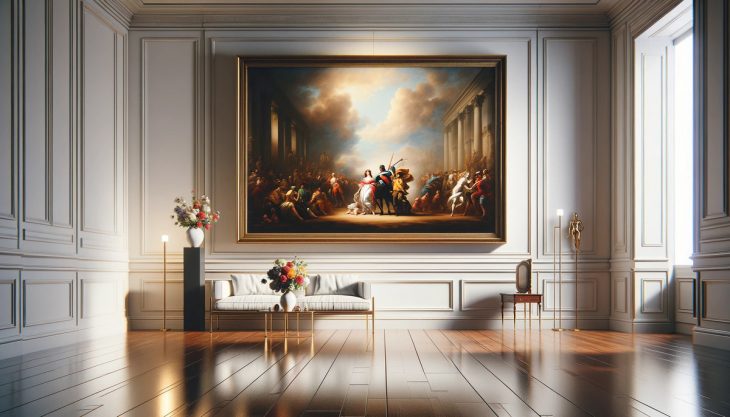
In the realm of interior design and art appreciation, the allure of original paintings by famed artists has always been paramount. However, with the advent of high-quality reproductions, art enthusiasts and interior designers have found a new avenue to bring the essence of these masterpieces into everyday spaces. Reproduction paintings are not mere copies; they are a tribute to the original works, offering accessibility and versatility to art lovers worldwide. In this comprehensive exploration, we delve into the features, uniqueness, and advantages of incorporating reproduction paintings into interior design.
The Art of Reproduction: More Than Just a Copy
Reproduction paintings are artworks that have been recreated to closely resemble an original painting. These are often hand-painted, ensuring that the brushstrokes, color palette, and overall essence of the original work are meticulously preserved. Websites like 1st Art Gallery offer an extensive collection of these artworks, providing an opportunity to own a piece of art that is visually and emotionally akin to a renowned masterpiece.
Uniqueness in Every Stroke
Each reproduction painting is unique in its own right. While the aim is to closely emulate the original, the individual artist’s interpretation and technique add subtle nuances, making each reproduction a one-of-a-kind piece. This aspect of uniqueness is particularly appealing to those who value the individuality of an artwork, even if it is a reproduction.
Features of High-Quality Reproductions
High-quality reproduction paintings are characterized by several key features:
Fidelity to Originals: High-quality reproductions are not just visual copies; they embody the original’s spirit, meticulously replicating its composition, color scheme, and artistic techniques. This level of fidelity ensures that the reproductions carry the same emotional and visual impact as the originals.
Skilled Artisanship: These reproductions are the result of skilled artisanship. Artists adept in the techniques of historical masters invest their expertise and creativity, ensuring each stroke resonates with the style and flair of the original creator.
Quality Materials: The choice of materials plays a crucial role. Premium quality paints and durable canvases are used, which not only contribute to the visual authenticity of the reproductions but also ensure their longevity, allowing them to be cherished for generations.
Attention to Detail: The essence of a masterpiece lies in its details. High-quality reproductions pay homage to this by focusing meticulously on every aspect, from the subtlest brushstroke and shading to the exact play of light and shadow, capturing the essence and soul of the original artwork.
The Charm of Accessibility
Original masterpieces by renowned artists are often inaccessible to the general public and housed in museums or private collections. Reproduction paintings, however, make these stunning works of art accessible. Art enthusiasts can bring home a Van Gogh, a Monet, or a Da Vinci, experiencing the joy of living with great art.
Exploring Different Art Movements
Within the world of reproduction paintings, there is a diverse range of art movements and styles to explore. From the romanticism of Turner’s landscapes to the abstract expressionism of Pollock, reproduction paintings allow art enthusiasts to delve into various artistic movements that may not have been accessible otherwise. This versatility offers an opportunity for interior designers to experiment with different aesthetics and moods within their projects.
Customization and Personalization
Many providers of reproduction paintings offer customization options. This means that art lovers can request specific modifications or sizes to suit their individual preferences and interior spaces. This level of personalization allows for a more tailored approach to incorporating art into home decor or commercial design.
Educational Value
Reproduction paintings can serve as educational tools. They allow viewers to closely examine the techniques and styles of renowned artists, gaining a deeper understanding of art history and the evolution of artistic movements. Interior spaces adorned with reproduction paintings can become living galleries, fostering an appreciation for art in both residents and visitors.
Art as an Investment
While original masterpieces often appreciate in value, high-quality reproduction paintings can also hold value, especially when created by skilled artists and using premium materials. As such, they can be considered both decorative pieces and potential investments, making them a wise choice for those looking to enhance their living spaces while considering long-term value.
Local Artisan Collaborations
Many reproduction painting providers collaborate with local artists, fostering a sense of community and supporting the arts. These collaborations can result in unique pieces that capture the essence of a famous artwork while incorporating elements of the local culture and creativity. This connection to the community adds depth to the artwork’s story.
Curation and Display
Interior designers often play the role of curators when incorporating reproduction paintings into their projects. The careful selection and placement of these artworks can enhance the overall design and atmosphere of a space. By strategically choosing which reproductions to feature and where to display them, designers can create captivating visual narratives.
Art Conservation
The popularity of reproduction paintings contributes to the preservation of original artworks. As more individuals become interested in renowned artists through reproductions, museums, and galleries can receive increased attention and support for their preservation efforts. This symbiotic relationship between reproductions and originals ensures the continued enjoyment of cultural treasures.
Online Accessibility
In today’s digital age, acquiring reproduction paintings has become more accessible than ever. Numerous online platforms offer a vast selection of artworks, making it convenient for art enthusiasts to explore and purchase reproductions from the comfort of their homes. This digital accessibility has democratized art appreciation and collection.
Cultural Appreciation
Reproduction paintings also serve as a means of cultural appreciation and exchange. They allow individuals from different backgrounds to connect with the art and history of various regions and periods. For instance, a reproduction of a traditional Chinese landscape painting can transport viewers to ancient China, fostering a deeper understanding and appreciation of Chinese culture. This cultural exchange through art enriches our global perspective.
Art Therapy and Well-being
Beyond their decorative and educational value, reproduction paintings can contribute to psychological well-being. Art therapy has gained prominence as a therapeutic tool, and having meaningful artworks in one’s living or working environment can promote relaxation, creativity, and emotional healing. The presence of art, even in reproduction form, can positively impact the mental and emotional state of individuals.
Supporting Emerging Artists
Some reproduction painting providers collaborate with emerging artists to recreate famous works. This collaboration not only introduces new talent but also provides opportunities for these artists to showcase their skills and gain recognition. Collecting reproduction paintings featuring the work of emerging artists can be a way to support their careers and artistic development.
Ethical Considerations
When collecting reproduction paintings, it’s essential to consider the ethics of art production and ownership. Ensure that the reproductions you purchase are created in ethical and sustainable ways. Many reputable providers prioritize fair compensation for artists and use environmentally responsible materials, aligning with ethical consumption practices.
The Future of Reproduction Art
As technology continues to advance, the future of reproduction art may hold exciting developments. Virtual reality and augmented reality technologies are already being used to create immersive art experiences. These innovations could potentially revolutionize how we interact with reproduction paintings, allowing us to step inside the world of a masterpiece or explore an artist’s creative process in unprecedented ways.
Conclusion
In conclusion, reproduction paintings have evolved into more than just decorative pieces; they are gateways to culture, sources of well-being, and platforms for emerging artists. Ethical considerations play a role in their acquisition, and the future promises exciting technological advancements in the world of reproduction art. As these paintings continue to captivate art lovers and interior designers, their significance in the art world remains enduring and dynamic, bridging the gap between history, culture, and personal expression.
Was this page helpful?
Our commitment to delivering trustworthy and engaging content is at the heart of what we do. Each fact on our site is contributed by real users like you, bringing a wealth of diverse insights and information. To ensure the highest standards of accuracy and reliability, our dedicated editors meticulously review each submission. This process guarantees that the facts we share are not only fascinating but also credible. Trust in our commitment to quality and authenticity as you explore and learn with us.


